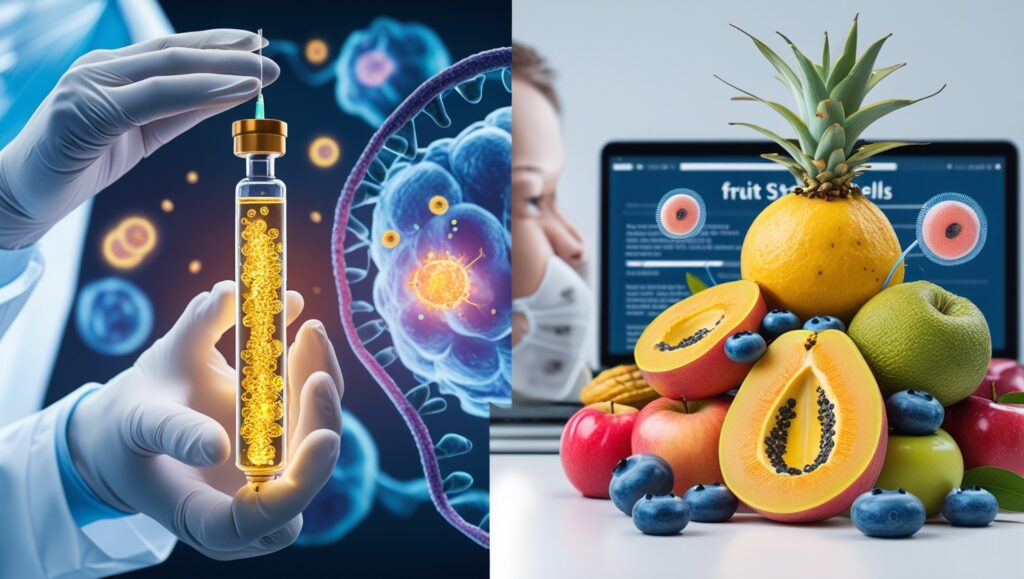Have you seen those YouTube videos claiming that fruit has more stem cells than placenta injections? Sounds great, right? Just eat an apple and heal your body! But here’s the truth: it’s complete nonsense.
Yes, fruit is healthy. It’s full of vitamins, antioxidants, and fiber. But if you’re looking for real, functional stem cells that can actually regenerate tissue, fight disease, and slow aging, you won’t find them in fruit. Let’s break it down.
Do Fruits Have Stem Cells? Well… Yes, But No.
You might have seen videos saying things like, “Apples and berries are packed with stem cells!” And they’re right… sort of. Plants do have stem cells — but they are nothing like human stem cells.
Big Difference: Plant vs. Human Stem Cells
Plant stem cells help plants grow and heal, but they can’t turn into human tissue. They won’t rebuild joints, regenerate skin, or fix nerve damage.
Human stem cells — especially those from placenta injections — can transform into different types of tissue, repair injuries, and trigger healing throughout the body.
If plant stem cells worked like human stem cells, we could grow a new liver from an avocado. But biology doesn’t work that way!
Why Placenta Injections Are the Real Deal
Now, let’s talk about placenta-derived stem cells and why they are far more powerful than anything you’ll get from fruit.
1. Placenta Injections Contain Healing Growth Factors
Placenta injections contain growth factors, cytokines, and peptides — bioactive molecules that:
✔ Repair damaged tissue
✔ Boost collagen production (hello, anti-aging!)
✔ Support the immune system
Fruit: Antioxidants that help prevent damage but don’t actually rebuild tissue.
Placenta Injections: Growth factors that stimulate actual healing.
2. Placenta Injections Contain REAL, Functional Stem Cells
The placenta is one of the richest sources of mesenchymal stem cells (MSCs) — the kind that actually repair bone, cartilage, muscle, and even nerve tissue.
Fruit: No human-compatible stem cells.
Placenta Injections: Powerful regenerative cells that work inside your body.
3. Placenta Therapy Is Used in Medicine — Fruit Isn’t
Doctors use placenta-based therapies for:
✔ Arthritis & joint pain
✔ Wound healing
✔ Anti-aging treatments
✔ Sports injuries & nerve damage
Fruit is great for nutrition, but it won’t regrow cartilage or repair nerve damage.
Fruit: Helps maintain health but doesn’t reverse damage.
Placenta Injections: Used worldwide to heal tissue and restore function.
4. Placenta Injections Work FAST — Fruit Works Slowly
If you have chronic pain, inflammation, or aging skin, you don’t want to wait years for subtle dietary benefits.
Placenta injections go straight into the bloodstream and start working immediately, triggering powerful cellular repair.
Fruit: Slowly supports overall wellness.
If fruit stem cells could regenerate organs, we’d have hospitals handing out smoothies instead of doing transplants. Real stem cells come from living tissues, not your grocery cart. The internet loves a cheap shortcut, but when it comes to regeneration, science—not marketing—wins.

Placenta Injections: Provide Fast, Targeted Healing and Regeneration
So, Should You Stop Eating Fruit?
Not! Fruit is great for overall health, and you should keep eating it. But let’s be real — if you need serious regenerative healing, it’s time to ditch the “fruit stem cell” myth and focus on science-backed solutions like placenta therapy.
The Bottom Line:
Eat fruit for health.
Use placenta injections for regeneration.